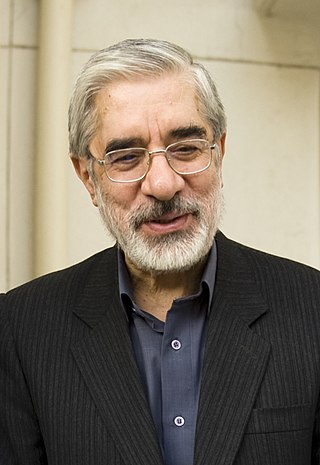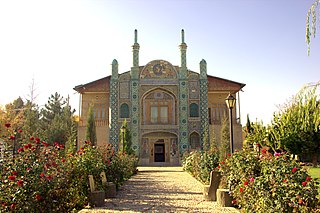
Iran, also known as Persia and officially as the Islamic Republic of Iran, is a country located in West Asia. It is bordered by Iraq and Turkey to the west, by Azerbaijan and Armenia to the northwest, by the Caspian Sea and Turkmenistan to the north, by Afghanistan and Pakistan to the east, and by the Gulf of Oman and the Persian Gulf to the south. It covers an area of 1.64 million square kilometres, making it the 17th-largest country. With an estimated population of 86.8 million, Iran is the 17th-most populous country in the world, and the second largest in the Middle East. Its largest city is the capital Tehran, followed by Mashhad, Isfahan, Karaj, Shiraz, and Tabriz.

Mehdi Karroubi is an Iranian Shia cleric and reformist politician leading the National Trust Party. Following 2009–2010 Iranian election protests, Karroubi was put under house arrest in February 2011 – reportedly ordered by the Supreme Leader of Iran – without officially being charged, although he is accused of being a "seditionist" and "traitor". As of 2021, he is still confined to his house.

Mir-Hossein Mousavi Khameneh is an Iranian reformist politician, artist and architect who served as the 49th and last Prime Minister of Iran from 1981 to 1989. He was a reformist candidate for the 2009 presidential election and eventually the leader of the opposition in the post-election unrest. Mousavi served as the president of the Iranian Academy of Arts until 2009, when conservative authorities removed him. Although Mousavi had always considered himself a reformist and believed in promoting change within the 1979 Revolution constitution, on 3 Feb 2023, in response to the violent suppression of Iranians by Ali Khamenei, the Supreme Leader of Iran, he announced opposition to the Islamic Republic constitution and asked for a widespread referendum to fully change the constitution and make a fundamental change in Iran's political system.

Iranian studies, also referred to as Iranology and Iranistics, is an interdisciplinary field dealing with the research and study of the civilization, history, literature, art and culture of Iranian peoples. It is a part of the wider field of Oriental studies.

Touraj Daryaee is an Iranian Iranologist and historian. He currently works as the Maseeh Chair in Persian Studies and Culture and the director of the Dr. Samuel M. Jordan Center for Persian Studies at the University of California, Irvine.

The Imam Sadiq University is an Islamic private university in Tehran, Iran. Established in 1982, the goal of the university is to bridge the gap between Islamic researches and modern studies, especially humanities. Imam Sadiq was established on the premises that used to house the Harvard School of Management until the 1979 Iranian Revolution.

One of the most dramatic changes in government in Iran's history was seen with the 1979 Iranian Revolution where Shah Mohammad Reza Pahlavi was overthrown and replaced by Ayatollah Ruhollah Khomeini. The authoritarian monarchy was replaced by a long-lasting Shiite Islamic republic based on the principle of guardianship of Islamic jurists,, where Shiite jurists serve as head of state and in many powerful governmental roles. A pro-Western, pro-American foreign policy was exchanged for one of "neither east nor west", said to rest on the three "pillars" of mandatory veil (hijab) for women, and opposition to the United States and Israel. A rapidly modernizing capitalist economy was replaced by a populist and Islamic economy and culture.
Abu al-Hassan Muhammad ibn Yusuf al-Amiri was a Muslim theologian and philosopher who attempted to reconcile philosophy with religion, and Sufism with conventional Islam. While al-'Amiri believed the revealed truths of Islam were superior to the logical conclusions of philosophy, he argued that the two did not contradict each other. Al-'Amiri consistently sought to find areas of agreement and synthesis between disparate Islamic sects. However, he believed Islam to be morally superior to other religions, specifically Zoroastrianism and Manicheism.

Gholamali Bayandor was the Commander of the Imperial Iranian Navy from 1931 to August 25, 1941, and was killed during the Anglo-Soviet invasion of Iran. He was born in Tehran to ancestors from Bayandur tribe.

Bojnord, known in the Middle Ages as Buzanjird, is a city in the Central District of Bojnord County, North Khorasan province, Iran, and serves as capital of the district, county, and province. It is about 701 km (436 mi) from Tehran. and 237 km away from Mashhad, the capital of Razavi Khorasan province.

The Encyclopaedia Islamica is an encyclopedia on Islamic and Iranian studies published by Brill, comprising a projected 16-volume translation of selected articles from the new Persian Dā'erat-ol-Ma'āref-e Bozorg-e Eslāmi, supplemented by additional articles written in English by scholars affiliated with the Institute of Ismaili Studies.
The Center for the Great Islamic Encyclopedia(Center for Iranian and Islamic Studies) (CGIE) is a major Iranian research institute with the task of researching and publishing general and topical encyclopedias about Iranian and Islamic culture. Within the Islamic and Iranian research landscape, it is one of the leading and most prestigious institutions in the country, attracting scholars from all over the region. The centre has one of the largest libraries on Iranian and Islamic culture. The building was nominated for the Aga Khan Award for Architecture in 2001.
The following is a timeline of the history of the city of Tehran, Iran.
Ahmad Motevaselian, an Iranian military attaché, was one of four Iranians who disappeared in Lebanon in 1982. During the Iran–Iraq War, he was a commander in the Islamic Revolutionary Guard Corps and established the 27th Muhammad Rasoolullah Division of Tehran. He played a role in the Liberation of Khorramshahr and later, as part of a senior diplomatic group of political and military leaders, went to Syria. On 5 July 1982, when the vehicle carrying the diplomats was passing through a checkpoint post on its way to Beirut, it was intercepted by Phalange Party. The car and four passengers, completely disappeared.
The second Iranian Assembly of Experts election was held on October 8, 1990, to elect all 83 members in 24 constituencies. The election was the first election of the assembly since Ayatollah Khomeini's death and election of Ali Khamenei as the new Supreme Leader. This election had the lowest turnout in the history of the Islamic Republic of Iran with 37.09% of the eligible voters participating.
The Iranian Parliament Committee on Economic, or Economic Committee is a standing committee of the Islamic Consultative Assembly of Representatives. The Parliament Committee on Economic has general economic, and it can recommend funding appropriations for various governmental agencies, programs, and activities, as defined by House rules. in the 11th parliament; Mohammad Reza Pour Ebrahimi was president, Kazem Mousavi first deputy and TBD second deputy.
Media Kashigar was a writer, translator, and poet. More than 20 books of Kashigar have been published in Iran. He was also active for the literary awards in Iran. He was a cultural activist. He was present during the visit of Laurent Fabius in Tehran in 2015.
Tālīsh is a historical and geographical region near the southwestern coast of the Caspian Sea, an area of compact residence of the Talysh people. It got its name from the ethnonym of the Talysh people inhabiting it.
The Comprehensive History of Iran is a twenty-volume book series about various aspects of Iran's political, social and cultural history from pre-Islamic times to the extinction of the Qajar dynasty. The research, compilation and writing of this multi-volume book has lasted for 14 years. The first five volumes of this series narrate the period of ancient Iran and the other 15 volumes narrate the history of Iran in the Islamic period, political, social, cultural, scientific, literary and artistic history. One hundred and seventy foreign and domestic authors have been used to write this multi-volume book.

Foucault in Iran: Islamic Revolution After the Enlightenment is a book by Iranian-born American historian, sociologist, and professor Behrooz Ghamari-Tabrizi as a groundbreaking reassessment of Michel Foucault's writings specially on the Iranian revolution.










